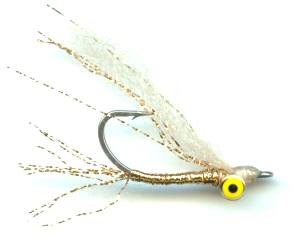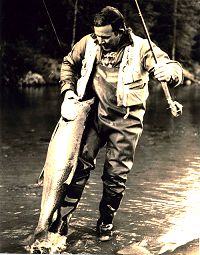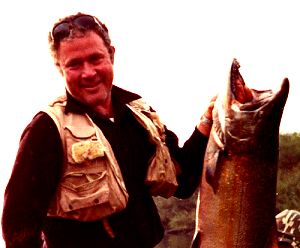Gold Christmas Island Special Bonefish Fly
The Christmas Island Special was developed from the inverted hook Crazy Charlie saltwater bonefish fly. It has heavier eyes to enable it to get to the bottom quicker in deeper water.

INVERTED HOOK PATTERNS. Hook size 6 & 4 - $US each
Fly Fisherman Bob Nauheim from California developed the Crazy Charlie for fishing bonefish on the flats. He designed it whilst fishing with the Bahamian fishing guide Charlie Smith of Charlie's Haven on Andros Island, in the Bahamas in the late 1970's. The north end of the Andros island has enjoyed a long reputation as a bonefish hotspot, but anglers are also starting to sample the bonefish fishing opportunities of the southern end. Bob designed the fly based on Charlie's lifelong observations of the eating habits of Bonefish. Charlie's father was a captain out of Walker's Cay who guided big game anglers including Herman Gray and Ernest Hemmingway. Charlie was born on Abaco in 1936 and at the age of six caught his first Bonefish. His father would not let him play with his professional tackle so he made his own
Bob Nauheim originally tied it to emulate glass minnows but soon realized that the bonefish were taking it as a shrimp. Instead of naming the fly after himself like so many other tiers he called it 'Bonefish Charlie Smith'. When it first took fish Charlie could not stop saying "Dat fly nasty!" because of the staring eyes. The fly was then called 'Nasty Charlie'. Bob took the fly pattern to Key West and showed it to Captain Jan Isley who had great success with it on the fussy Keys bonefish. Jan was the first to tie the fly with a hair wing. Bob then took it to the Christmas Island when that mid-pacific atoll first opened to bonefish fishing. The first saltwater fly fishers reported that the island's bonefish refused all their offerings. Bob was very successful with his new pattern. When he got back to the American mainland Leigh Perkins of Orvis called him to find out how the fishing was on the Christmas Island had been. Leigh was planning a trip there and wanted to know what worked. He took Bob's fly with him and had a great fishing trip. He liked it so much that he arranged for it to be commercially tied and marketed through Orvis. Leigh inadvertently changed the name 'Nasty' to 'Crazy'. The Crazy Charlie name stuck.

Bob Nauheim sitting tying a Crazy Charlie fishing fly
Robert (Bob) Milton Nauheim, lost his fight against cancer 9th September 2005, aged 71. A former Californian SRFD Santa Rosa firefighter and renowned fly fisherman. Bob inherited his love of fishing, hunting and the natural sciences from his father and by the time he was ten years old, they had fished throughout California, Colorado, Montana, Maine and Canada. Later Bob frequently fished the Florida Keys and Mexico. Fishing International www.flishinginternational.com was founded by Bob in 1974. It is an adventure travel agency specializing in sports fishing. Bob Nauheim's favorite river was the Russian River in Northern California fishing for steelhead and salmon. Bob founded the Russian River Fly Fishing Club and through his company and his magazine articles in Outdoor Life and Angler magazine he helped pioneer the development of Costa Rica, Christmas Island, New Zealand and Venezuela as ultimate fishing destinations. Bob's ashes were scattered into the Russian River.
It is designed to be kept at or near the bottom to catch the bottom feeders. The original pattern consisted of a silver flashabou tail, a body of silver tinsel over wrapped with clear mono, a cream hackle wing, silver bead chain eyes with white thread. Since the original was so successful, a huge number of color variations have been tried (many with hair wings instead of feathers) and found to be quite successful. This is our version.

Bob Nauheim inventor of the Crazy Charlie fishing fly
This fly is an inverted hook pattern. It is designed so that the hook rides above the shank in the water. The idea is that the hook does not get caught on the bottom. By adding a relatively stiff wing material near the hook eye which covers the hook point, the fly becomes nearly weedless. Other inverted hook patterns are dressed to create inversion by bending the hook, by adding weighted eyes on the hook shank opposite the point and/ or by using relatively buoyant materials to cover the hook point. Any of these three techniques can cause the fly to ride inverted. If tied with sparse materials these flies can be made to sink very fast. This fly will bounce up and down on the retrieve and makes puffy little clouds on the bottom that sends out visible signals to nearby fish who interpret it as, there is something moving down there that maybe good to eat.
Because the Crazy Charlie fly rides hook up it consequently does not gill hook many fish unlike the conventional hook down fly. Although the fly was not designed with this feature in mind it has increased the amount of fish that can be caught and released. In nature if you can be seen your dead. Most prey species of the bonefish are very well camouflaged. Your fly must not mimic nature too well for if it cannot be seen you will not catch fish.
Subtle colored flies work best on sunny, bright days in shallow water. Bright colored flies work best on cloudy days in deeper water or at sunset. Bonefish patterns should match the color of the bottom in the area you are fishing: light colored flies on light sandy bottoms and dark colored flies on dark turtle grass/coral bottoms. Flies that hit the water with little impact are more effective than those that strike heavy and spook the fish. Stock your bonefish fly box with: Bonefish Specials, Crazy Charlies, Clouser Minnows (The top three producers in order are: Tan and White Clouser Minnow, Chartreuse-white Clouser Minnow (Chartreuse = light green) and Pink-white Clouser Minnow) and lastly Horror flies for spooky fish.
Bonefish have a nickname of "ghosts of the flats". They spend much of their time in shallow water and are very well adapted to it. They are streamlined and very fast. There shape gives them the ability to sneak around with the minimum of surface disturbance and their speed lets them change locations very quickly if threatened. This speed and preferred habitat make them one of the worlds most sought after sporting fish. You have to work for your catch. Most Bonefish found in shallow water are 2 to 5 pounds but they can go as heavy as 15 pounds in deeper water. A thirty inch bonefish will be about twenty years old. A twenty five inch will be about 10 years old and a twenty inch will be about four years old.

Bob Nauheim designer of the Crazy Charlie bonefish fishing fly
Bonefish know that if they reach the crest of a flat on an incoming tide they will find the best food waiting for them. Look at your tide tables and find the crest. Sometimes schools of Bonefish will rush towards there as the tide turns and starts to flood. Getting a take is all about placement and delivery in front of your target.. Sometimes it does not matter if your fly is tan or orange.
On my last trip my guide spotted a single Bonefish grubbing in the mud about 50 feet from the boat in perhaps 18 inches of water. I managed to get a perfect cast to it, started retrieving and felt the line tighten as the the fish took. The normal advice at this point is to keep retrieving, not strike, as the the fish will generally hook itself. it worked. For a couple of seconds the fish jut shook it's head, not knowing what had happened to it. then it took of in a flash. these fish are really fast. In seconds all the fly line and half the backing had gone from the reel. I eventually landed a nice 6lb bonefish.
With a slow moving fish I have been able to get a a bite by casting behind the tail (admittedly the first time I did this was by mistake and a short cast). I noticed the fish visible change directions as it heard the plop of the fly. It must have thought that some thing was alive behind it and trying to escape. It wheeled around and went to investigate. It saw the puffs of sand as I retrieved and it attacked. It does not always work but is a good last resort option that has claimed a number of bonefish.
One little tip is to keep your hands clean. Bonefish have a powerful sense of smell. They can smell crabs and shrimps they cannot see. They can also smell, insect repellant, beer, sunblock, gasoline and aftershave. I wasted a whole days fishing. I was using a lot of sunblock because I did not want to get sunburnt as I had very white English skin that had not seen the sun for five months. I was getting frustrated an being the only one not catching fish when my guide pointed out my error. After I thoroughly cleaned my flies my luck changed. A number of our Crazy Charlie flies have heavy lead eyes. This makes them sink to the bottom quicker than the regular Crazy Charlies. These are ideal for fishing in deeper water.
Another tip is to be aware of your location in relation to any coral reefs. There is no excuse to step on live coral and kill thousands of of living organisms. It is too precious. It provides a hiding place and food source from many different fish. A healthy environment leads to good fishing grounds. Another reason for not treading on coral is that it can rip your footwear to pieces and an even better one is that coral cuts fishing line. When you finally hook a bonefish the last thing you want is for your leaded to be severed.
If you want to fish where this fly was born check out the www.bangbangclub.com and visit Charlie Smith's Haven at Behring Point. Please note that the Crazy Charlie is also a great fly for fishing North American Gulf Coast Redfish
Bonefish very rarely take with a 'bang'. They catch up with the fly and suck it in. All you normally feel is a change in tension on the line as you strip. That is the only indication you get that the bonefish has taken your fly. Beginners tend to strike with the rod, lifting it as you might lift into a trout taking a dry fly. What you should do is the moment you feel the fly being sucked in by the fish, you keep stripping hard. You will find that the line will tighten, at which point strip/strike the line with the rod tip still pointing at the fish, only lifting the rod when your sure the hook is home. That is when the Bonefish will take off. You better be ready for the fight and hold on tight to your rod. These fish pack a punch.. On my first Bonefish trip I made the mistake of using a fly rod that reflected the sun. It spooked the fish again and again. I now use a dark matt carbon rod with no shiny parts. Fish that are very prone to aerial predator attack get very spooky.
If you are out fishing for bonefish and see a Permit do not panic if you forgot to pack some crab flies. Permit will feed on shrimp if they are easy to catch. Shrimp flies like Crazy Charlies and Christmas Island Specials, have to be fished right on the bottom but mid depth can bring results. I have had results with a heavy eyed yellow Crazy Charlie. One good head shot is worth twenty side casts when fishing shrimp flies to permit.
When out fishing for bonefish look for 'Bonefish Mud'. What am I talking about? Sand and silt is kicked up into suspension when a group of bonefish root along the bottom searching out food. They 'color' the water along the area of the beach. The water looks all cloudy. 'Bonefish mud' is a great indicator of activity and an easy way of locating Bonefish. Cast your fly into this location.
When ever you see a ray swimming near by it is always worth casting just behind it. Even if you cannot see any following bonefish they will follow in its wake. The movement of the Rays wings as they glide over the surface disturb the sea bed and dislodges shrimps and crabs. The bonefish love an easy meal.


Bonefish fishing books

